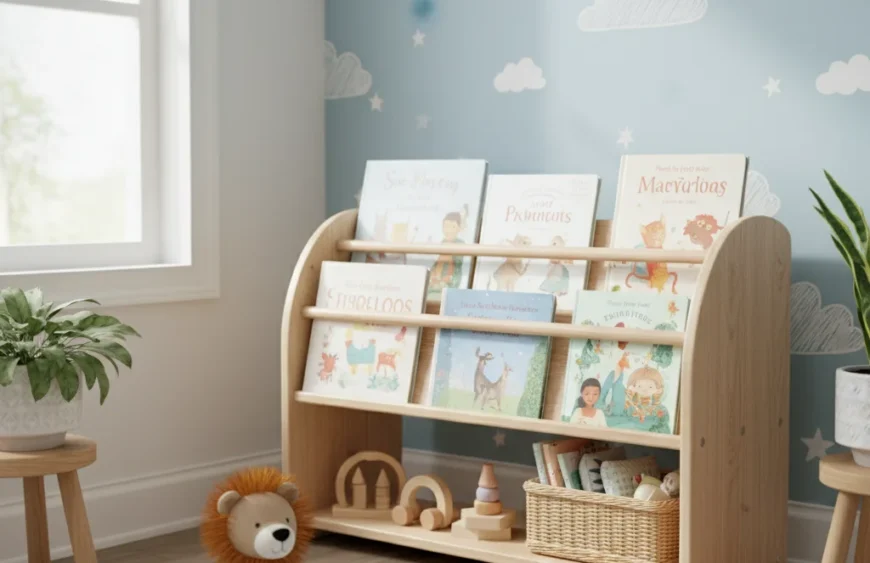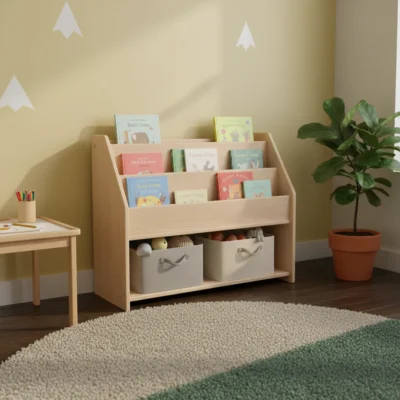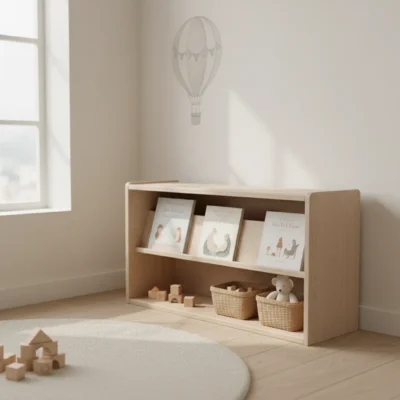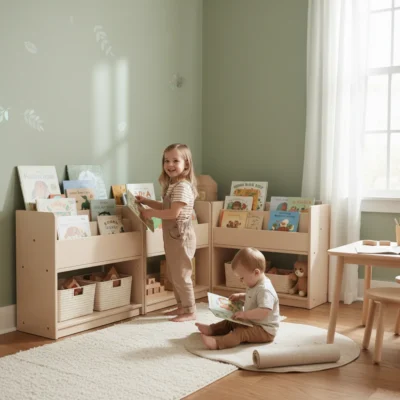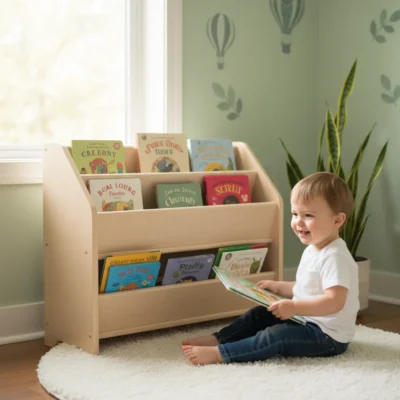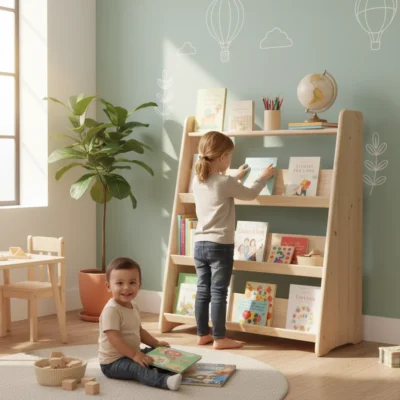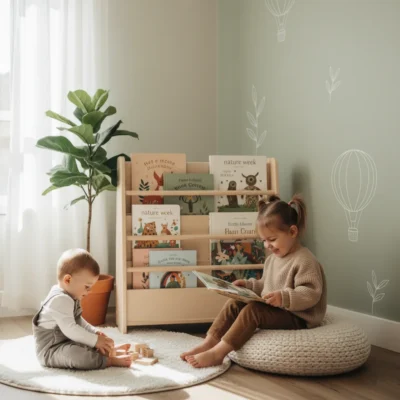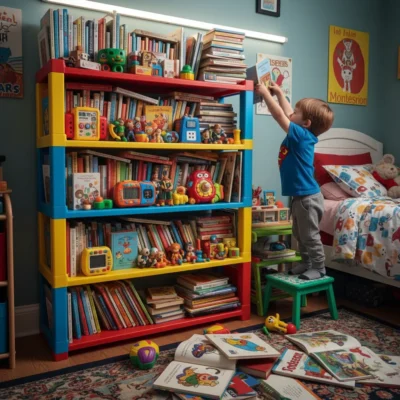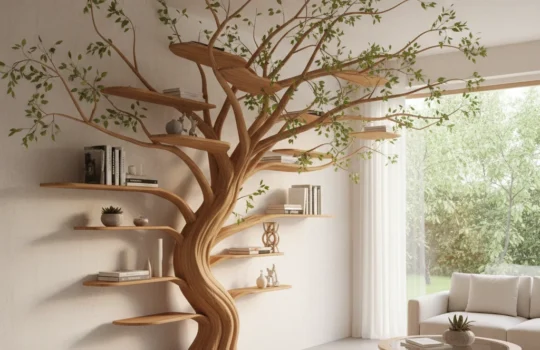The Montessori philosophy is all about giving children the freedom to explore and learn at their own pace. It encourages independence, concentration, and responsibility, values that start with something as simple as how a child’s environment is arranged.
Every item in a Montessori home has a purpose. From the height of a table to the placement of a toy, the environment is designed to empower children to do things “by themselves.” One of the most essential pieces of Montessori furniture is the bookshelf—a simple, child-sized structure that allows kids to independently choose and care for their books.
In this guide, we’ll explore how to choose the perfect Montessori bookshelf for your child’s room, focusing on functionality, design, and how it supports your child’s growth and love of reading.
Why a Montessori Bookshelf Matters
A Montessori bookshelf isn’t just furniture, it’s a learning tool. The way it’s designed helps children develop independence and organizational skills while fostering a genuine interest in reading.
Here’s why it matters:
- Encourages independence: A low, open bookshelf allows children to pick out books on their own, without needing adult help. This simple act builds confidence and decision-making skills.
- Promotes order: Each book has its place. Children learn the value of tidiness by returning items to their proper spots after use.
- Inspires a love for reading: When books are displayed with covers facing out, they naturally attract a child’s attention, much like a display in a bookstore.
- Builds responsibility: Managing their own book collection teaches kids to care for their belongings.
A Montessori bookshelf is not about storing books, it’s about creating an environment where learning happens naturally.
Key Features to Look For
When choosing the right Montessori bookshelf, keep in mind that form should follow function. Every design element should make it easier for your child to explore independently and safely.
Height and Accessibility
Montessori shelves are always child-sized. The ideal height allows your child to reach every book without climbing or asking for help.
- For toddlers (1–3 years): Choose shelves around 20–24 inches tall.
- For preschoolers (3–6 years): 24–30 inches tall is ideal.
The goal is for your child to easily see, choose, and return books on their own, this sense of accessibility nurtures confidence and autonomy.
Material and Safety
Natural materials are a key part of Montessori design. Look for:
- Solid wood or bamboo, finished with non-toxic paint or oil.
- Rounded edges and smooth surfaces to prevent injuries.
- Sturdy construction, so the shelf won’t tip over even when a curious toddler leans on it.
Avoid plastic or overly colorful shelves, they often clash with the calm, natural aesthetic that Montessori environments aim for.
Design and Aesthetic
A Montessori space should feel peaceful and uncluttered.
- Opt for simple, minimalist designs without cartoon characters or bright colors.
- Neutral tones such as white, beige, or light wood, help keep the environment soothing and focused.
- A bookshelf that blends with the room’s natural theme encourages calm concentration.
Functionality and Flexibility
A good Montessori bookshelf grows with your child.
- Choose open-front designs, so book covers are visible and inviting.
- Look for modular or adjustable shelves that can be rearranged as your child gets older.
- Lightweight designs are ideal, you can easily move them to refresh your child’s reading corner or adjust for different activities.
Montessori Bookshelf Types: Which One Fits Your Space?
There isn’t just one “right” Montessori bookshelf. The best option depends on your child’s age, your available space, and how you plan to organize their room. Here are a few popular types:
Front-Facing Bookshelf
This design displays book covers outward instead of showing the spines. It’s perfect for toddlers who can’t yet read titles. Seeing the pictures helps them remember their favorite stories and encourages them to pick books independently.
Low Open Shelf
A versatile option that works for books, baskets, and learning materials. The open design supports self-directed play—your child can easily access books, puzzles, or art supplies.
Corner Bookshelf
Ideal for small rooms. A triangular or L-shaped design makes use of otherwise wasted space and can create a cozy reading nook.
Multi-Level Shelf
Perfect for families with more than one child. Each level can hold age-appropriate materials, promoting organization and cooperation among siblings.
How to Arrange Books the Montessori Way
Once you’ve chosen the perfect shelf, the next step is arranging it thoughtfully. Montessori environments prioritize order and intentionality and that includes book displays.
Here’s how to do it:
- Limit the number of books. Keep around 5–10 books on display at a time. Too many choices can overwhelm young children.
- Rotate regularly. Swap books every few weeks to maintain your child’s curiosity.
- Group by theme or interest. For example, a “nature week” collection or “feelings and friendship” theme.
- Display covers facing out. Visual presentation invites exploration and sparks excitement about reading.
- Add a reading corner. Place a small rug, cushion, or child-sized chair next to the bookshelf to create a cozy reading space.
By curating the bookshelf this way, you transform it from storage into an interactive learning station that evolves with your child’s development.
Common Mistakes to Avoid
Even with the best intentions, some setups can work against Montessori principles. Avoid these common pitfalls:
- Shelves that are too tall: If your child needs help to reach a book, the independence factor is lost.
- Overcrowded shelves: Too many books create clutter and confusion. Keep it simple and organized.
- Bright, distracting designs: Flashy colors or cartoon patterns can make it harder for children to focus.
- Mixing too many toys with books: The bookshelf should remain primarily for reading materials.
A Montessori environment is about simplicity and purpose, less is always more.
Creating a Space That Grows with Your Child
Choosing the right Montessori bookshelf is about more than finding a piece of furniture, it’s about building an environment that supports your child’s natural curiosity and independence.
When you choose a child-sized, safe, and thoughtfully designed bookshelf, you’re sending a powerful message: “I trust you to explore, to choose, and to learn on your own.” That’s the heart of Montessori education. So take your time, select a shelf that matches your child’s needs and your home’s aesthetic, and watch as your little one falls in love with the world of books—one story at a time.
